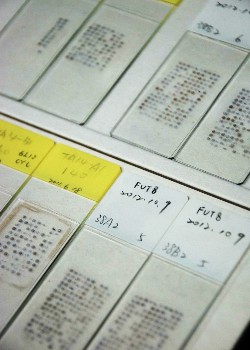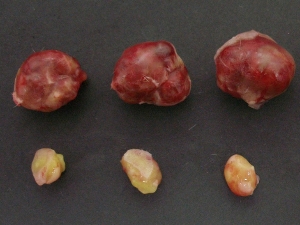With a persistent quest and clever collaborations, digging clue after clue, a team in Dr. Chi-Huey Wong’s research group has identified the role of FUT8, an enzyme which adds sugar molecules to proteins; their study showed FUT8 matters a LOT in human nonsmall cell lung cancer (NSCLC). A paper of their work has been published on PNAS in January 2013, and was reported by A-IMBN later.
 Using tissue microarray, about 140 patients were analyzed for FUT8 expression.
Using tissue microarray, about 140 patients were analyzed for FUT8 expression.
The team led by Dr. Wong possesses high interest in finding out the correlation between glycosylation and malignant tendency in tumor cells.Malignant tumor cells are the ones that tend to break away from an original tumor and enter the lymphatic system or the bloodstream to form new tumors in other parts of the body (aka metastasis). The team has a goal to find out whether glycosylation is the cause or the result.
FUT8 is the abbreviation for fucosyltransferase 8, basically, it is an enzyme observed in the course of glycosylation, and has been observed in several malignant cancers including liver, ovarian, thyroid, and colorectal already. Chien-Yu Chen, first author of the published paper of this study, determined to find out if FUT8 has a role in NSCLC, which currently has the highest mortality rate among all cancers in Taiwan.
Led by Dr. Pan-Chyr Yang, National Taiwan University Hospital (NTUH) has a team renowned for its lung cancer research. The NTUH team has accumulated clinical specimens for establishing the correlation of genome and the nature of malignant tendency of NSCLC.
At the very beginning of this study, Chen used two cell lines provided by Yang’s group, and proved that FUT8 is also abundant in the more vicious NSCLC.
Next, they need to know if this is also true with other lung cancer patients. For that, a journey on the translational research path became critical.
Chen continued the work with the team in NTUH. Together they have analysed 47 clinical cases. A final result of ninety percents of NSCLC altogether showed overexpression of FUT8, and FUT8 expression proved to be much lower in the normal lung tissue derived from the same patient.
At the same time, Dr. Michael Hsiao, an associate researcher of GRC has been working closely with Dr. Ming-Shyan Huang and Dr. Chih-Jen Yang of Kaohsiung Medical University Hospital (KMUH) for various studies. The team has created an array that accumulates 140 clinical cases on 3 chips, which allowed the analysis of FUT8 protein expression in more NSCLC specimens.
The team in KMUH, Hsiao and his graduate student Yi-Hua Jan then helped with analyzing the medical histories of the 140 patients, not only to double confirm that FUT8 has a clear correlation with the malignancy, they have also reported an indicative statistical figure that high FUT8 expression goes hand in hand with clinical cases of NSCLC patients that had recurrences and metastasis.
 Without FUT8, the tumor cell has much less malignancy and grows much slower.The team then went back to the laboratory and started another task. They knocked down the FUT8 gene and made comparison. Consistent with prior analysis, the resulting data showed, in-vitro and in-vivo, without FUT8, the tumor cell has much less malignancy and grows much slower. The team made the conclusion at that point - FUT8 contributes to the malignancy of NSCLC.
Without FUT8, the tumor cell has much less malignancy and grows much slower.The team then went back to the laboratory and started another task. They knocked down the FUT8 gene and made comparison. Consistent with prior analysis, the resulting data showed, in-vitro and in-vivo, without FUT8, the tumor cell has much less malignancy and grows much slower. The team made the conclusion at that point - FUT8 contributes to the malignancy of NSCLC.
The story did not stop there! Now that they are sure FUT8 is the suspect, so, why FUT8 got overexpressed in the first place?
Chen spotted the difference of the cell shapes from the high and low FUT8 expression groups. It is known that when a mild tumor cell turned malicious, it will go through a transition called EMT (epithelial-mesenchymal transition). So, by inducing EMT, it did start to shape differently, along with an increase of FUT8 expression.
Mining the transcription factors that potentially act on FUT8 promoter, then, they were able to single out one single factor called β-Catenin, which proved to be THE transcription factor during gene expression that has caused FUT8 to go wild and later caused the tumor cell to become vicious.
Case closed for this chapter, but the journey on the translational research will go on now that there is a model illustrating the relation between FUT8 expression and lung cancer progression. The collaboration has provided a promising direction for the prognosis and therapy of lung cancer.